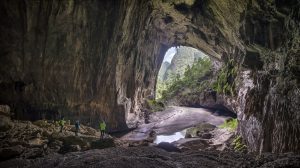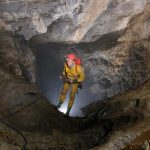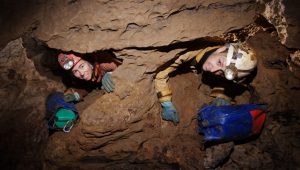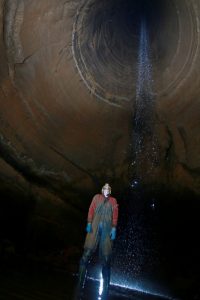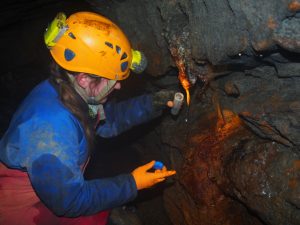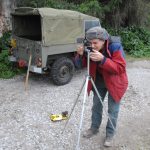Finalised Programme
Friday evening
Friday
Frank Pearson – Dark Horizons: 50 Years of Cave Exploration in the British Isles
Friday 19:10 – 19:35 – ![]() Watch lecture
Watch lecture
Chair: Andy Eavis
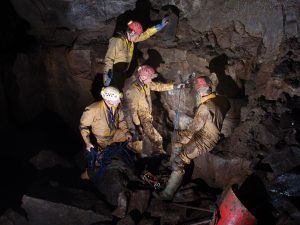 In a country as densely populated as Britain, the chance of exploring boundless unknown regions seems remote, yet the underground remains one of the last great unexplored environments, and the subterranean wilderness of the deep air draws cavers in ever deeper and ever further. The limestone that holds caves is found throughout the British Isles. Hidden by nature, these caves are found, extended and linked together by ecological detective work, chance, tenacity and a ‘long neck’. Over the last 50 years, cavers from around the country have continued to explore caves of great length, depth and beauty in the Mendips, the Forest of Dean, Wales, the Peak District, the Yorkshire Dales and the far north of Scotland. This presentation will introduce you to some of the subterranean wonders found in the hidden recesses of natural Britain.
In a country as densely populated as Britain, the chance of exploring boundless unknown regions seems remote, yet the underground remains one of the last great unexplored environments, and the subterranean wilderness of the deep air draws cavers in ever deeper and ever further. The limestone that holds caves is found throughout the British Isles. Hidden by nature, these caves are found, extended and linked together by ecological detective work, chance, tenacity and a ‘long neck’. Over the last 50 years, cavers from around the country have continued to explore caves of great length, depth and beauty in the Mendips, the Forest of Dean, Wales, the Peak District, the Yorkshire Dales and the far north of Scotland. This presentation will introduce you to some of the subterranean wonders found in the hidden recesses of natural Britain.
Dick Willis – 50 Years of Wonder
Friday 19:35 – 20:00 – ![]() Watch lecture
Watch lecture
Chair: Andy Eavis
 If expedition caving was an Olympic activity, the UK would hold all the medals. Since the 70’s (and even before) British cavers have been travelling overseas in search of the deepest, longest, biggest, scientifically interesting and most beautiful caves on the planet. Expeditions have gone out across all continents, from the frozen north of Greenland to the hot, humid tropics, from the deserts of the Middle East to the stark beauty of Tibet. Aided by technical developments in equipment and cave mapping and sustained by vast reserves of good humour, we’ve had successes everywhere.
If expedition caving was an Olympic activity, the UK would hold all the medals. Since the 70’s (and even before) British cavers have been travelling overseas in search of the deepest, longest, biggest, scientifically interesting and most beautiful caves on the planet. Expeditions have gone out across all continents, from the frozen north of Greenland to the hot, humid tropics, from the deserts of the Middle East to the stark beauty of Tibet. Aided by technical developments in equipment and cave mapping and sustained by vast reserves of good humour, we’ve had successes everywhere.
Dr. Gina Moseley – Recent advances in British-led cave science
Friday 20:30 – 20:55 – ![]() Watch lecture
Watch lecture
Chair: Andy Eavis

 Science and exploration go hand in hand. In some cases, scientific research is driven by the discoveries that are made in caves, in other cases, exploration is driven by the need to advance scientific understanding. In this presentation, Dr. Gina Moseley of the University of Innsbruck and previous winner of the BCRA Young Cave Researcher of the Year, will present an overview of the major advances in British-led cave science that have been made in recent years, as well as those projects that are pushing the boundaries of knowledge today.
Science and exploration go hand in hand. In some cases, scientific research is driven by the discoveries that are made in caves, in other cases, exploration is driven by the need to advance scientific understanding. In this presentation, Dr. Gina Moseley of the University of Innsbruck and previous winner of the BCRA Young Cave Researcher of the Year, will present an overview of the major advances in British-led cave science that have been made in recent years, as well as those projects that are pushing the boundaries of knowledge today.
Her journey will take us from the projects that are being conducted in Britain today, where researchers are engaging in citizen science to help locate Britain’s lost ice caves, and where a decade-long cave dig has yielded the most complete archive of Late Pleistocene-early Holocene palaeoenvironmental change known in Britain. She’ll also explore the varied work that is being conducted by British universities worldwide: from understanding permafrost dynamics in Greenland and Siberia, to sea-level change and hurricane paths in the Caribbean, to a Saharan desert that was wet and vegetated, and finally to the age, formation and stability of some of the largest and longest caves in the tropics.
Howard Limbert – Giant Caves of Central Vietnam
Friday 20:55 – 21:25 – ![]() Watch lecture
Watch lecture
Chair: Andy Eavis
This presentation will show a short history of the British teams investigation into the this truly amazing karst area. Over 500 caves have been explored in Vietnam by British teams with remarkable success including exploring the longest river cave in the world as well as the largest cave passage yet discovered. The major part of the talk will be on the discovery of Hang Son Doong a truly unique cave hidden until 2009 deep in the karst massif. The talk will show how the cave was found and explored after years of searching this remote area. Images will show the giant main passage and the superb formations seen throughout the cave.
Exploration Saturday
Saturday
Saturday AM – Yorkshire, Mendip, Wales
Saturday PM – WORLD (including Mulu, China, America, Africa, India, Vietnam)
Frank Pearson – Mountains and Rivers: 50 years of Cave Exploration in the Yorkshire Dales
Saturday 11:30 – 12:00 – ![]() Watch lecture
Watch lecture
Chair: Robin Weare
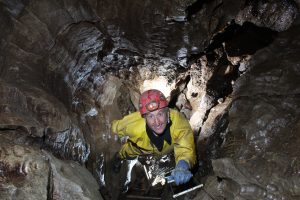
 The deep and wide bed of limestone that sits on top of the Alston Block in the northern Pennines, ‘the deep air’s unmeasured wilderness,’ continues to reveal new caves. The Dales already has the longest cave system, the largest chamber and some of the deepest caves in the country, it also has groups of cavers determined to find more. The Three Counties Cave system is still being extended and the link to Kingsdale is being pushed by divers. New passages and entrances continue to be found in the Gaping Gill system, and sumps continue to be dived further and deeper. Barbondale, Dentdale, Nidderdale and Malham are disclosing their secrets, and the long and serious caves of Wharfedale are being explored through formidable difficulties by cavers and divers. The extent of unknown cave in the Dales is potentially massive, stretching away unseen beneath the glaciated fells, and feeding miles of mountain rivers. This presentation will introduce you to the caves and characters of the Dales from the last 50 years of exploration.
The deep and wide bed of limestone that sits on top of the Alston Block in the northern Pennines, ‘the deep air’s unmeasured wilderness,’ continues to reveal new caves. The Dales already has the longest cave system, the largest chamber and some of the deepest caves in the country, it also has groups of cavers determined to find more. The Three Counties Cave system is still being extended and the link to Kingsdale is being pushed by divers. New passages and entrances continue to be found in the Gaping Gill system, and sumps continue to be dived further and deeper. Barbondale, Dentdale, Nidderdale and Malham are disclosing their secrets, and the long and serious caves of Wharfedale are being explored through formidable difficulties by cavers and divers. The extent of unknown cave in the Dales is potentially massive, stretching away unseen beneath the glaciated fells, and feeding miles of mountain rivers. This presentation will introduce you to the caves and characters of the Dales from the last 50 years of exploration.
Les Williams – The Mendip Hills
Saturday 12:00 – 12:30 – ![]() Watch lecture
Watch lecture
Chair: Robin Weare
The Mendip Hills have a long history of exploration, with pretty much all the discoveries there being the result of a lot of hard work by many people over the years. There are many groups digging, searching for new caves or extensions to known caves on a regular basis. Their hard work and commitment has paid off many times and this presentation will try to show effort put in by the diggers and to showcase the superb discoveries that have been made over the years.
Andy Freem – The Golden Age of Cave Exploration in Wales and the Forest of Dean
Saturday 12:30 – 13:00 – ![]() Watch lecture
Watch lecture
Chair: Robin Weare

 Wales and the nearby Forest of Dean have a subterranean world ingrained in their geological and social fabrics. Four regions with karst landforms plus a high energy coastline, have created a great variety of speleological features. There is a rich history of cave discovery revealing many huge, ancient, abandoned networks and also active stream caves of drama and beauty. Added to this natural world has been the influence of mining. Search for new caves continues and there are a number of enticing locations that could reveal further large discoveries. So prepare for busy and adventurous half hour!
Wales and the nearby Forest of Dean have a subterranean world ingrained in their geological and social fabrics. Four regions with karst landforms plus a high energy coastline, have created a great variety of speleological features. There is a rich history of cave discovery revealing many huge, ancient, abandoned networks and also active stream caves of drama and beauty. Added to this natural world has been the influence of mining. Search for new caves continues and there are a number of enticing locations that could reveal further large discoveries. So prepare for busy and adventurous half hour!
Dave Brook – An Era of Exploration
Saturday 13:00 – 13:30 – ![]() Watch lecture
Watch lecture
Chair: Chris Jewell
The explosion of cave exploration in the Dales in the 1960s and 70s began in 1966 with the discovery of Kingsdale Master Cave. The historical lead up to the event is briefly described and tales of adventures and mishaps that occurred during some of the following notable explorations throughout the Dales will be recounted.
Tony Whitten – Fighting for cave and karst biodiversity
Saturday 13:30 – 14:00
Chair: Chris Jewell
In a book published by The World Bank almost 20 years ago (Vermeullen & Whitten, 1999) we argued that the biodiversity of limestone areas used for quarrying cannot be dealt with in the same way as a normal development project. Since then efforts have been made to engage a variety of cement companies to acknowledge and act on this knowledge. In this talk, examples of good and bad practice (some surprising) will be given from southeast Asia, looking at both multi-national and local cement companies. Some suggestions on ongoing and potential means to improve the situation will be made – though not all will likely be acceptable to the audience!
Colin Boothroyd – The Mulu Caves Project
Saturday 15:30 – 16:00 – ![]() Watch lecture
Watch lecture
Chair: Dick Willis

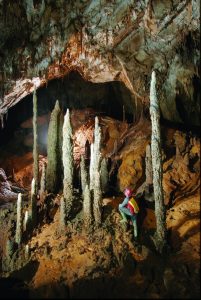 Mulu – this is the name of one of the most famous caving regions around the world. But oddly enough Mulu, or Gunong Mulu to give it its full title, is a sandstone mountain that is completely devoid of any caves!However, it is the grandparent that both oversees and nourishes the younger limestone mountains that gather around its flanks. The heavy rain that falls upon Gunong Mulu in Northern Borneo does not hide underground. The downpours gather as streams and rivers and then head for the limestone. And when they reach their target they don’t mess around: they go caving. They have been doing that for millions of years. The result is a selection of the biggest and best caves anywhere to be found – all waiting to be explored.
Mulu – this is the name of one of the most famous caving regions around the world. But oddly enough Mulu, or Gunong Mulu to give it its full title, is a sandstone mountain that is completely devoid of any caves!However, it is the grandparent that both oversees and nourishes the younger limestone mountains that gather around its flanks. The heavy rain that falls upon Gunong Mulu in Northern Borneo does not hide underground. The downpours gather as streams and rivers and then head for the limestone. And when they reach their target they don’t mess around: they go caving. They have been doing that for millions of years. The result is a selection of the biggest and best caves anywhere to be found – all waiting to be explored.
Madphil Rowsell – Caving behind the Great Wall – China
Saturday 16:00 – 16:30 – ![]() Watch lecture
Watch lecture
Chair: Dick Willis

 China is the worlds 3rd to 4th biggest country but boasts a significant amount of the worlds limestone. This makes it a irresistible draw to cavers. British Cavers first went to China in the early 1980’s and found a welcoming country, full of caves (what more could you ask for!). This talk is about the caves themselves and the experience of caving in China from those early days up to the present day, highlighting the changes that China has undergone in these 35 or so years.
China is the worlds 3rd to 4th biggest country but boasts a significant amount of the worlds limestone. This makes it a irresistible draw to cavers. British Cavers first went to China in the early 1980’s and found a welcoming country, full of caves (what more could you ask for!). This talk is about the caves themselves and the experience of caving in China from those early days up to the present day, highlighting the changes that China has undergone in these 35 or so years.
Chris Jewell – British Cave Exploration in the Americas
Saturday 16:30 – 16:50 – ![]() Watch lecture
Watch lecture
Chair: Dick Willis
A whirlwind tour of British exploration in the Americas (Northern, Central and Southern). From the mid 60’s to the present day British cavers have been joining their counterparts across the Atlantic to explore and map caves. From the cold icy caves of Canada to the warm waters of the Bahamas, the western hemisphere provides a backdrop to many great tales of cave exploration.
Robin Weare – 50 years of exploration in Africa
Saturday 16:50 – 17:10 – ![]() Watch lecture
Watch lecture
Chair: Dick Willis

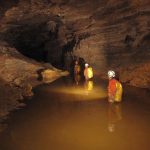 Exploration of the caves in the Dark Continent has been neglected compared with other parts of the world. However, British teams have explored and mapped caves in others in The High Atlas, Namibia, Madagascar and Ethiopia where British cavers explored and mapped Sof Omar, mainland Africa’s longest cave, as well as hundreds of others. This talk will describe meetings with gun toting and sometimes sleepy guards, sacrificial goats, hyenas, skeletons and histoplasmosis. It will include the tragedy of a failed attempt to rescue villagers lost in a cave and will visit Africa’s highest potato field and the real source of the Nile (honestly).
Exploration of the caves in the Dark Continent has been neglected compared with other parts of the world. However, British teams have explored and mapped caves in others in The High Atlas, Namibia, Madagascar and Ethiopia where British cavers explored and mapped Sof Omar, mainland Africa’s longest cave, as well as hundreds of others. This talk will describe meetings with gun toting and sometimes sleepy guards, sacrificial goats, hyenas, skeletons and histoplasmosis. It will include the tragedy of a failed attempt to rescue villagers lost in a cave and will visit Africa’s highest potato field and the real source of the Nile (honestly).
Simon Brooks – Caving in the Abode of the Clouds Project, Meghalaya, North East India
Saturday 17:10 – 17:30 – ![]() Watch lecture
Watch lecture
Chair: Dick Willis
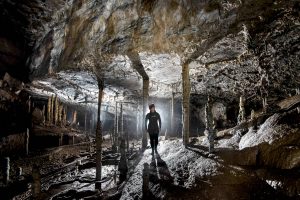
 The Caving in the Abode of the Clouds Project takes its name from the Sanskrit meaning of the word “Meghalaya” which literally translates to ‘Abode of the Clouds’. This wonderfully describes the fact that at certain times of the year this Indian state is cloaked in thick cloud, resulting in world record rainfall. This project has recorded the whereabouts of over 1,600 caves and cave locations, yielding in excess of 468 kilometres of measured (and of which a significant portion is mapped) cave passage, with much more awaiting discovery. Many of the caves explored to date contain impressive river passages, deep shafts and large and ancient relic passage, which together create cave systems equal in size and beauty to caves found anywhere else in the world. Justifying Meghalaya’s status on the world-caving map as a significant Cave and Karst Region.
The Caving in the Abode of the Clouds Project takes its name from the Sanskrit meaning of the word “Meghalaya” which literally translates to ‘Abode of the Clouds’. This wonderfully describes the fact that at certain times of the year this Indian state is cloaked in thick cloud, resulting in world record rainfall. This project has recorded the whereabouts of over 1,600 caves and cave locations, yielding in excess of 468 kilometres of measured (and of which a significant portion is mapped) cave passage, with much more awaiting discovery. Many of the caves explored to date contain impressive river passages, deep shafts and large and ancient relic passage, which together create cave systems equal in size and beauty to caves found anywhere else in the world. Justifying Meghalaya’s status on the world-caving map as a significant Cave and Karst Region.
Paul Ibberson – Vietnam – Three Decades of Cave Exploration
Saturday 17:30 – 18:00 – ![]() Watch lecture
Watch lecture
Chair: Dick Willis

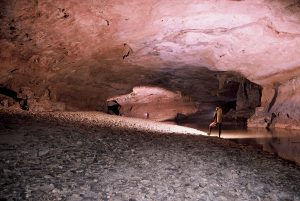 Since 1990, British cavers have been at the forefront of the systematic exploration of the karst areas of Vietnam, with over 400km of cave surveyed. The majority of the 16 major expeditions undertaken in that time have focused on Quang Binh province in central Vietnam, but significant discoveries have also been made elsewhere, especially in the northern provinces of Cao Bang and Lang Son. The presentation will showcase the spectacular caves, landscape and people of this fascinating country and give an insight into the changing nature of caving there.
Since 1990, British cavers have been at the forefront of the systematic exploration of the karst areas of Vietnam, with over 400km of cave surveyed. The majority of the 16 major expeditions undertaken in that time have focused on Quang Binh province in central Vietnam, but significant discoveries have also been made elsewhere, especially in the northern provinces of Cao Bang and Lang Son. The presentation will showcase the spectacular caves, landscape and people of this fascinating country and give an insight into the changing nature of caving there.
Exploration Sunday
Sunday
Sunday AM – The Peak District, Devon, Scotland, Ireland
Sunday PM – EUROPE (including Austria, Spain, Slovenia)
Sid Perou – Caving and Television
Sunday 09:00 – 10:00 – ![]() Watch lecture
Watch lecture
Chair: Andy Eavis
This talk will be looking as the vast changes that have occured over the last 50 years in caving, but also in the attitude of both the media and the public to it, and the part caving expeditions and the subsequent discoveries (particularly film and photographs) have played in that change of perception. The talk will also look at the dramatic change in technology and how much the new digital technology has changed what is now possible. It will include the complete film about the history of cave filming.
Simon Brooks – Cave exploration in The Peak District
Sunday 11:30 – 12:00 – ![]() Watch lecture
Watch lecture
Chair: Nick Williams
The Peak District predominantly lies within the Counties of Derbyshire and Staffordshire, one of Britain’s oldest National Parks, famous for its stunning limestone and gritstone landscapes. Within what is essentially a Limestone Plateau there are many fine caves with documentation of these extending back to the 16th Century. Lead miners, also known as ‘t’owd man, who were very active in the Peak District had knowledge of many of the more well know caves, particularly those intersected by the Mines. With notable cave discoveries taking place from the late 1920’s onwards the casual observer can be forgiven for thinking that most of ‘what could be found, has been found’. However, ongoing exploration is still very active within the Peak District, particularly in the last 10 years which have seen some significant discoveries. This lecture gives an overview of the landscapes of the Peak District, the Geology and the Caves. Outlining significant discoveries from 1926 to date and the exploration techniques that have led to the unearthing of these spectacular finds.
Pete Glanvill – Caves and Caving in Devon
Sunday 12:00 – 12:20 – ![]() Watch lecture
Watch lecture
Chair: Nick Williams

 Devon, which could claim to be the birthplace of British cave archaeology offers challenges to the sporting caver and cave diver. Devonian limestone is one of the oldest types found in the British Isles and the outcrops are scattered over a wide area. There are caves of great and unusual beauty in these rocks. Most but not all the caves were formed below the water table and have been exposed by quarrying. Some of the largest patches of limestone have few caves associated with them and there is considerable scope for future discoveries. The talk will briefly describe the major cave systems around Buckfastleigh, the intriguing intertidal and submarine caves to be found on the limestone cliffs around Torquay, Brixham and Plymouth, and some of the minor caves in the region.
Devon, which could claim to be the birthplace of British cave archaeology offers challenges to the sporting caver and cave diver. Devonian limestone is one of the oldest types found in the British Isles and the outcrops are scattered over a wide area. There are caves of great and unusual beauty in these rocks. Most but not all the caves were formed below the water table and have been exposed by quarrying. Some of the largest patches of limestone have few caves associated with them and there is considerable scope for future discoveries. The talk will briefly describe the major cave systems around Buckfastleigh, the intriguing intertidal and submarine caves to be found on the limestone cliffs around Torquay, Brixham and Plymouth, and some of the minor caves in the region.
Alan Jeffreys – 100 years under Scotland’s floor
Sunday 12:20 – 12:40 – ![]() Watch lecture
Watch lecture
Chair: Nick Williams

 This talk will review use of Scottish caves from prehistoric times (some people think many Scots still use them!) and the gradual indigenous exploration by home-grown caving clubs. On the way we shall glance at the popularity of caves by renegades such as William Wallace and Bonnie Prince Charlie, examine early archaeological clearance where diggers were urged ‘not to set fire to the cave’ (!) and expand on the recent revelation that limestone outcrops all over the country appear to have interesting – if sometimes cramped – cave systems. Cannibals, saints, ancient bears and dilettanti, Scottish caves have seen them all, and only now are they being documented by ‘proper’ speleologists.
This talk will review use of Scottish caves from prehistoric times (some people think many Scots still use them!) and the gradual indigenous exploration by home-grown caving clubs. On the way we shall glance at the popularity of caves by renegades such as William Wallace and Bonnie Prince Charlie, examine early archaeological clearance where diggers were urged ‘not to set fire to the cave’ (!) and expand on the recent revelation that limestone outcrops all over the country appear to have interesting – if sometimes cramped – cave systems. Cannibals, saints, ancient bears and dilettanti, Scottish caves have seen them all, and only now are they being documented by ‘proper’ speleologists.
Tim Fogg – Father Ted’s Holy Ground: The exploration of Ireland’s caves
Sunday 12:40 – 13:00 – ![]() Watch lecture
Watch lecture
Chair: Nick Williams

 A glance at the geological map of Ireland will gladden the heart of any caver as limestone underlies a huge part of the island. Every one of its 32 counties has speleological interest. Tourist cavers from ‘across the water’ have played a huge role in the advancement of cave exploration since the 1600’s, but the island’s small population has produced a steady flow of hard, dedicated explorers.
A glance at the geological map of Ireland will gladden the heart of any caver as limestone underlies a huge part of the island. Every one of its 32 counties has speleological interest. Tourist cavers from ‘across the water’ have played a huge role in the advancement of cave exploration since the 1600’s, but the island’s small population has produced a steady flow of hard, dedicated explorers.
Martyn Farr – The Darkness Beckons: The History and Development of Cave Diving
Sunday 13:00 – 13:20 – ![]() Watch lecture
Watch lecture
Chair: Les Williams
Martyn Farr has been exploring underwater caves from 1970. In 1981 and 1982 he set world records for the longest penetration of an undersea cave in the Bahamas. He made the very first scuba cave dive in China in 1985 and the first in Borneo the year before. His caving travels have taken him to many countries across the globe. Over the past few years he has been exploring virgin caves in New Zealand – discovering several miles of hitherto unknown cave passages in the process.
Ric Stanton – Cutting Edge British Cave Divers Abroad
Sunday 13:20 – 13:40 – ![]() Watch lecture
Watch lecture
Chair: Les Williams
This presentation will be about how a very select group of British cavers who specialised in caving underwater, expanded their techniques to become leaders in the field of long range European cave diving. This lead to a series of cutting edge, technical explorations, which will be outlined, along with some of the equipment required and problems overcome. This continued development eventually paved the way for the longest penetration of a series of flooded tunnels ever to be explored from a single source; at a distance of almost 10km underwater.
Ed Waters – Beneath the Volcanoes: The exploration of lava tube caves
Sunday 13:40 – 14:00 – ![]() Watch lecture
Watch lecture
Chair: Les Williams

 Unlike the slow processes that create limestone caves, lava tube caves are created in a few weeks or months in the violence of volcanic eruptions. British cavers have been at the forefront of the exploration of lava tube caves for over 40 years, and this talk will describe some of the memorable events that have occurred during that time. As well as looking back to the considerable past achievements of British Vulcanospeleologists, the exciting future of the exploration of lava tubes will be discussed. It is enough to say that the prospects are out of this world…
Unlike the slow processes that create limestone caves, lava tube caves are created in a few weeks or months in the violence of volcanic eruptions. British cavers have been at the forefront of the exploration of lava tube caves for over 40 years, and this talk will describe some of the memorable events that have occurred during that time. As well as looking back to the considerable past achievements of British Vulcanospeleologists, the exciting future of the exploration of lava tubes will be discussed. It is enough to say that the prospects are out of this world…
Richard (Roo) Walters & Pete Smart – Why are the World’s Largest Chambers so Big?
Sunday 14:00 – 15:00 – ![]() Watch lecture
Watch lecture
Chair: Andy Eavis
The World’s largest cave chambers are demonstrably stable, despite their very great spans, and evidence of extensive collapse . In many cases, they are also getting bigger. Their stability arises from the formation of cantilevered beam or Vousoir arch ceilings, the latter developing in very massive beds, and having higher width to height ratios than the former (compare Sarawak Chamber, Malaysia and Cloud Ladder Hall, China). Very high chambers may also develop in more fractured zones where ravelling of ceiling blocks and upward stoping occur. Large chambers tend to form at the intersection of several passages at different levels. The largest chambers owe their volume to the effective evacuation of bedrock, and of clastic sediment, breakdown and speleothem, accumulation of which may lead to occlusion of the chamber void.
David Rose – Caving and the Media
Sunday 15:00 – 15:30 – ![]() Watch lecture
Watch lecture
Chair: Andy Eavis
The quantity and quality of coverage of caves and caving in the mainstream media has declined in recent years – despite the fact that the pace of cave exploration has never been so intense or exciting. Only 25 years ago, the legendary underground filmmaker Sid Perou was still able to attract support from prime time TV channels for his work, and newspapers, magazines and books aimed at the general reader ensured that news of important discoveries was widely disseminated. Today, commissioning editors across all media have, unaccountably, lost interest, both in exploration and the burgeoning field of cave science. As David Rose will demonstrate, such coverage as does appear is often laughably inaccurate, and dwells mostly on accidents. It is time, he will argue, for cavers to make a new effort to connect their world to a wider public.
Chris Howes – Lighting the Darkness: The History of Cave Photography
Sunday 15:30 – 16:00 – ![]() Watch lecture
Watch lecture
Chair: Andy Eavis
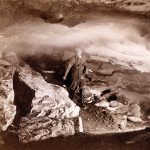
 Cave photography has become easier and a higher quality of image has become possible over the past few decades with the advent of digital cameras. Spare a thought, then, for the difficulties faced by the pioneers who were faced with not only basic cameras but also having to experiment with lighting the subterranean world. Chris Howes compares new systems of flash with old, taking us back into the mid-1800s to discover how early cave photographers overcame these challenges.
Cave photography has become easier and a higher quality of image has become possible over the past few decades with the advent of digital cameras. Spare a thought, then, for the difficulties faced by the pioneers who were faced with not only basic cameras but also having to experiment with lighting the subterranean world. Chris Howes compares new systems of flash with old, taking us back into the mid-1800s to discover how early cave photographers overcame these challenges.
Bill Whitehouse – 60 years of Cave Rescue
Sunday 16:00 – 16:30 – ![]() Watch lecture
Watch lecture
Chair: Andy Eavis
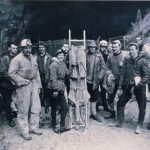
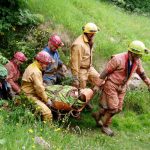 The UK is home to the oldest cave rescue teams in the world – two of them being formed over eighty years ago and most of the others over fifty years ago. Caving is unique in being the only sport that provides its own emergency service recognised by the Statutory Authorities.What happened before teams were formed, what brought about their formation and what events and criteria influenced their development into the service as it is today – fifteen volunteer teams throughout the British Isles with the British Cave Rescue Council as their national representative organisation?
The UK is home to the oldest cave rescue teams in the world – two of them being formed over eighty years ago and most of the others over fifty years ago. Caving is unique in being the only sport that provides its own emergency service recognised by the Statutory Authorities.What happened before teams were formed, what brought about their formation and what events and criteria influenced their development into the service as it is today – fifteen volunteer teams throughout the British Isles with the British Cave Rescue Council as their national representative organisation?
Thomas Starnes – Council of Higher Education Caving Clubs
Sunday 16:30 – 16:50 – ![]() Watch lecture
Watch lecture
Chair: Madphil Rowsell
CHECC is a national organisation set up to support and foster university caving clubs. Formed in 2002, the aim of the Council is to facilitate communication between university clubs in the UK in order to promote student caving and create opportunities for students to discover and develop within the sport and science of caving. Many university students go on to make invaluable contributions to cave exploration both in the UK and overseas. Here we provide a brief summary of university caving clubs’ contributions to original cave exploration.
Juan Corrin – Matienzo: a Spanish caving area for the connoisseur
Sunday 16:50 – 17:10 – ![]() Watch lecture
Watch lecture
Chair: Madphil Rowsell
Since 1969, over 900 Brits and other nationalities have enjoyed the 140 expeditions, exploring and documenting cave passages totalling 384 km in length across more than 4600 sites. World class cave networks include the Four Valleys System, approaching 60 km. Scientific activities include palaeo-climate studies with possible explanations for the demise of Neanderthals in the area.
One feature of the expeditions is the range of cave-related activities that are available for all ages and abilities: walking to spot new holes, tourist trips getting to know cave systems, digging out new entrances and pushing trips to find new routes.
Cave divers push water-logged routes and capable climbers bolt up vertical walls spurred on by dark recesses high above that might just be a passage. All the data collected is documented as cave surveys, photos, videos and cave descriptions then published online in a comprehensive web site, allowing future explorers to research then push on into new caves!
Aidan Marks – 40 Years in Austria: The Loser Plateau. Cambridge University Caving Club 1976-2017
Sunday 17:10 – 17:30 – ![]() Watch lecture
Watch lecture
Chair: Madphil Rowsell
Since 1976, CUCC have been visiting the Loser Plateau near Bad Aussee, Austria, to explore the Schwarzmooskogelhohle cave system. As of 2016, the cave is now over 120 km long and over 1000 m deep, making it one of the largest in Europe. The expedition is one of the largest and longest running student expeditions in the UK, and is one of the leading training grounds for students new to alpine caving to learn how to explore new alpine caves safely and scientifically.
Tanguy Racine – Under the Hollow Mountain: Exploring Slovenia’s longest cave system
Sunday 17:30 – 18:00 – ![]() Watch lecture
Watch lecture
Chair: Madphil Rowsell
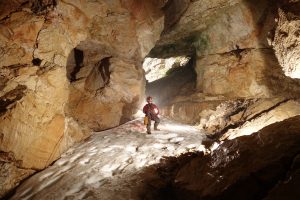
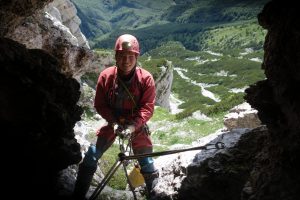 Since 1994, Imperial College Caving Club, along with our Slovenian friends in the JSPDT, have explored the alpine cave system beneath the mountain of Tolminski Migovec. Sistem Migovec is now the longest cave system in Slovenia at 39 km, and extends down to -975 m below the highest entrance. This talk will cover the history of exploration, including the connections between three smaller systems to make the current master system, the current focus of our exploration in the Primadona branch, and a look at how a successful student-run expedition can be sustained over many years.
Since 1994, Imperial College Caving Club, along with our Slovenian friends in the JSPDT, have explored the alpine cave system beneath the mountain of Tolminski Migovec. Sistem Migovec is now the longest cave system in Slovenia at 39 km, and extends down to -975 m below the highest entrance. This talk will cover the history of exploration, including the connections between three smaller systems to make the current master system, the current focus of our exploration in the Primadona branch, and a look at how a successful student-run expedition can be sustained over many years.
Cave Science
BRITAIN’S LIMESTONE CAVES – AN EVER GROWING RESOURCE
John Gunn, School of Geography, Earth & Environmental Sciences, University of Birmingham, Edgbaston, Birmingham, B15 2TT. j.gunn.1@bham.ac.uk
Saturday 10:10 – 10:35; ![]() Watch lecture; Chair: Gina Moseley
Watch lecture; Chair: Gina Moseley
 There is nowhere else on earth where there is a greater temporal range of carbonate rock outcrops in such a small geographical area as there is in mainland Great Britain. They comprise Quaternary freshwater carbonates, limestones and dolostones of Paleogene, Cretaceous, Jurassic, Permian, Carboniferous, Devonian, Silurian, Ordovician and Cambrian ages and Cambrian to Neoproterozoic metacarbonates. Geographically they extend from the southern coast of Devon to the northern coast of Scotland (about 900 km) and from the tip of western Wales to the Cliffs of Dover in the east (about 450 km). Surface karst landforms have developed on, and karstic drainage (via dissolutionally enlarged conduits) is present in, rocks of most ages but the vast majority of caves are in rocks of Early Carboniferous age. Caves are a valuable resource both for their recreational value and for the scientific importance of the chemical (speleothem) and clastic sediments deposited in them. This resource is not static but changes over geological time as small channels through the rock are enlarged by dissolution and become conduits some of which in turn are enlarged by dissolution and by mechanical erosion to eventually form cave passages (caves are simply conduits that have reached a size whereby they can be entered and explored by humans). It is also the case that over geological time active cave passages may become relict and their dimensions may be reduced by sediment fills such that they are no longer of accessible dimensions. Some may even become totally-filled and effectively ‘fossilised’. Read more
There is nowhere else on earth where there is a greater temporal range of carbonate rock outcrops in such a small geographical area as there is in mainland Great Britain. They comprise Quaternary freshwater carbonates, limestones and dolostones of Paleogene, Cretaceous, Jurassic, Permian, Carboniferous, Devonian, Silurian, Ordovician and Cambrian ages and Cambrian to Neoproterozoic metacarbonates. Geographically they extend from the southern coast of Devon to the northern coast of Scotland (about 900 km) and from the tip of western Wales to the Cliffs of Dover in the east (about 450 km). Surface karst landforms have developed on, and karstic drainage (via dissolutionally enlarged conduits) is present in, rocks of most ages but the vast majority of caves are in rocks of Early Carboniferous age. Caves are a valuable resource both for their recreational value and for the scientific importance of the chemical (speleothem) and clastic sediments deposited in them. This resource is not static but changes over geological time as small channels through the rock are enlarged by dissolution and become conduits some of which in turn are enlarged by dissolution and by mechanical erosion to eventually form cave passages (caves are simply conduits that have reached a size whereby they can be entered and explored by humans). It is also the case that over geological time active cave passages may become relict and their dimensions may be reduced by sediment fills such that they are no longer of accessible dimensions. Some may even become totally-filled and effectively ‘fossilised’. Read more
Over decadal (human) timescales the length of cave passage may be considered to be geologically constant although caves may be destroyed by human actions, most notably quarrying. However, the total cave length includes both known and unknown passages and the pace of exploration can be seen by the continuous increase in both the number of caves and of explored and surveyed passage. In 1989 a review of caving guide books and journals was undertaken and 2710 caves were identified with a total length of about 632 km (Hardwick & Gunn, 1989). By 2016 most known caves had been recorded in regional databases that listed over 5100 caves (this total excludes very short caves/digs and sea caves formed by mechanical processes in many rock types). There was also a substantial rise in the length of explored cave to over 977km and it is likely that when the next assessment is undertaken the total length will be over 1000km. Although new open caves are occasionally discovered the vast majority of ‘new’ cave passage has been found following the excavation of sediment and / or removal of rock, a process that is commonly undertaken over many months or even years and involves sustained effort and commitment. This makes caving unique amongst sports in that participants actively increase the resource base and in so doing make a significant contribution to science.
Reference
Hardwick, P. & Gunn, J. 1989. The limestone cave resources of Great Britain. Proceedings of the 10th International Congress of Speleology, Budapest, Hungary: 194-195.
SPELEOTHEM SCIENCE
Ian Fairchild, School of Geography, Earth and Environmental Sciences, University of Birmingham, B15 2TT. i.j.fairchild@bham.ac.uk
Saturday 10:35 – 11:05; ![]() Watch lecture; Chair: Gina Moseley
Watch lecture; Chair: Gina Moseley
Paralleling the “golden age of cave exploration” in which British cavers have played such a major role, over the past 30 years there has been an explosion of knowledge and understanding about how calcareous cave deposits (speleothems) record environments and climates today and in the past. Research on British sites, and more substantively by UK-based scientists on caves around the world, played a crucial role.
We now understand that we should regard caves as part of a system that transfers a weather and climate signal from the atmosphere, through the soil and the cavernous limestone bedrock into the cave. Carbonate minerals dissolve in the CO2-rich soil and CaCO3 reprecipitates when excess carbon dioxide degasses from the dripwater. Hence the cave itself has what we term a physiology in which heat, water and gases are exchanged. The regulated conditions also suggested the metaphor of an incubator. In the speleothem incubator, conditions of constant temperature and steadily dripping water can maintain steady growth of individual stalagmites up to 100 thousand years or so. Read more
Many speleothem researchers in contrast have focused their attention on much longer periods of time, seeking to build up records of the ice ages. This is possible since speleothems, as long as they lack a lot of suspended sediment, can be readily dated using the relative amounts of different uranium and thorium isotopes. In fact they can be much better dated than traditional archives of climate during the Quaternary Period (when the ice ages occurred). These archives are primarily marine cores from the deep sea and cores through the major ice sheets such as in Antarctica.
The most iconic records are from Chinese stalagmites from monsoonally influenced regions. Here the different isotopes of oxygen in rainwater vary through the year and depending on the intensity of the monsoon. This controls the oxygen isotope composition of dripwater and in turn that of the oxygen atoms contained in the CaCO3 speleothem. We know that over long periods of time there are climatic fluctuations whose timing is controlled by the so-called Milankovitch cycles – periodic wobbles in the Earth’s orbit that influence the amount of radiation received from the sun in different regions. These are beautifully preserved in the monsoon-proxy speleothems. Also preserved at times is a high-frequency variation which is also seen in studies in the Atlantic area – this reflects the stuttering Gulf Stream circulation during ice ages.
Speleothems are also a great climate archive because they have so many properties that can be climatically influenced. These include the growth rate itself, the isotopes of carbon preserved, the fluorescent properties of the organic matter, the abundance of a wide variety of trace elements, and the chemistry of water in tiny inclusions in the calcium carbonate. The carbon isotopes for examples may reflect abundances of plants with different photosynthetic modes, or total vegetational abundance, or relative importance of degassing (which can be seasonally modulated). A new frontier area is supplied by the use of biomarkers. These are specific groups of organic molecules extracted from the solid carbonate speleothem. It turns out that they often reflect colonies of bacteria – either in the soil or else growing in the cave itself.
CAVE ARCHAEOLOGY IN BRITAIN: SOME HIGHLIGHTS OF THE LAST FIVE DECADES
Andrew T. Chamberlain, School of Earth and Environmental Sciences, University of Manchester, Oxford Road, Manchester M13 9PT. andrew.chamberlain@manchester.ac.uk
Saturday 11:05 – 11:30; ![]() Watch lecture; Chair: Gina Moseley
Watch lecture; Chair: Gina Moseley
During the last fifty years our knowledge and understanding of the archaeology and late Quaternary palaeontology of British caves has been enhanced through discoveries and explorations of new sites, applications of new analytical methods, re-assessments of historical archives and advances in our theoretical understanding of cave usage and depositional processes. A wide range of interested parties have contributed to these advances in knowledge, including recreational cavers, amateur archaeologists, local authority archaeologists and historic environment managers, often working collaboratively with researchers based in universities, museums and national government organisations. Read more
During the 21st century we continue to benefit from ongoing advances in analytical methods, such as new biochemical techniques for sequencing biomolecules from ancient organic remains and the development of chemical methods for determining sources of raw materials used in ancient tool manufacture. The spectacular discovery in 2003 of Britain’s first Ice Age cave art at Creswell Crags served as a reminder that even long-known and frequently-visited caves sometimes yield their secrets slowly, and by inference that important events in the history of cave usage still remain to be found.
CAVE DEVELOPMENT: THE HOLE STORY
Andy Farrant, British Geological Survey, Keyworth, Nottingham, NG12 5GG. arf@bgs.ac.uk
Saturday 14:00 – 14:30; ![]() Watch lecture; Chair: Ian Fairchild
Watch lecture; Chair: Ian Fairchild
Caves come in a huge variety of shapes and sizes from very small passages to huge chambers bigger than a football stadium. Some caves are mostly vertical, sometimes over 2000 m deep, others are largely horizontal. The largest cave systems can be several hundred km long, forming complex multi-phase systems with active streamways, sumps, vertical shafts and relict passages long abandoned by the formative streams. Some are adorned with magnificent stalagmites and stalactites, some just full of mud. Some caves develop deep below the water table, accessible only by diving. Many more still await discovery.
Yet underlying this complexity, the vast majority of caves are formed by the dissolution of a soluble rock. A few are caused by land sliding or volcanic eruptions, but most are formed through the dissolution of limestone by the action of weakly acidic meteoric water (rain, snow). The addition of carbon dioxide from the air and more importantly from the soil and bedrock turns rainwater into weak carbonic acid. Microbial activity can also generate acidity. The action of this acid on limestone over millennia gradually enlarges any fractures or other discontinuities in the rock, eventually leading to the throughput of water and the formation of a conduit. When large enough for a human to enter, it becomes a cave. Other soluble rocks such as gypsum and salt dissolve in fresh water again leading to cave development. Read more
In some cases the acidity may be derived from other sources, such as the oxidation of sulphates within the host rock, microbial action, acidic brines rising up from depth to form ‘hypogenic’ caves, or by dissolution caused by the mixing of fresh and saline water in coastal aquifers. These often have a different form to ‘normal’ caves.
By examining caves, their morphology including features such as scallops, and any deposits it is possible to deduce how a particular cave may have formed. This in turn can lead to insights into the evolution of a cave system and the surrounding landscape.
AS OLD AS THE HILLS? THE CHRONOLOGY OF CAVES AND THEIR LANDSCAPES
Michael J. Simms, Curator of Geology, National Museums Northern Ireland, Cultra, Holywood, Co. Down, Northern Ireland, BT18 0EU. michael.simms@nmni.com
Saturday 14:30 – 15:00; ![]() Watch lecture; Chair: Ian Fairchild
Watch lecture; Chair: Ian Fairchild
As subterranean drainage routes, an intimate relationship exists between the evolution of a cave system and that of its containing landscape. As the surface landscape is modified by incision and/or surface lowering, so the underground drainage adapts to vertical and lateral shifts in input and exit points. Changes in the surface drainage pattern may substantially modify or even destroy evidence of earlier drainage routes but, in contrast, rerouting of underground drainage may effectively isolate, or even ‘fossilise’, older conduits and their contents. Sediments, speleothems and solutional scallops in relict or fossil conduits can provide evidence of former surface catchments, of flow direction and discharge, and of ‘water tables’ in the past. This evidence may survive virtually intact for substantial periods of time if not intercepted by surface lowering. As such, caves are the geological equivalent of the ‘back of the sofa’. Together the data gleaned from caves can form the basis for reconstructing landscapes that may once have existed tens or even hundreds of metres above the present surface.
Simple field observations of passage morphology, cross-cutting relationships, scallops, speleothems and sediments, combined with data from high quality surveys, can be used to establish a relative chronology of a cave system and of changes in its associated landscape. This can exercise the minds of cavers and geomorphologists regardless of the actual age of the cave system. Potentially it can also be a powerful tool for informing cave diggers of promising locations both within a cave system and across the broader landscape.Read more
Despite the limitations of the various techniques used for dating caves, and the natural barriers that they present to most ordinary mortals, limestone caves offer unparalleled opportunities for reconstructing, and dating, the evolution of the landscapes with which they are associated.
CAVE MICROCLIMATE
James Baldini, Associate Professor, Department of Earth Sciences, Durham University, Durham DH1 3LE, UK. james.baldini@durham.ac.uk
Saturday 15:00 – 15:30; ![]() Watch lecture; Chair: Ian Fairchild
Watch lecture; Chair: Ian Fairchild
Stalagmites have been used to reconstruct terrestrial palaeoclimate for decades, and are becoming increasingly well-established within the palaeoclimate community. However, how cave microclimate affects stalagmite growth (and the nature of the climate proxies retained within stalagmites) has only recently become well understood. Measurements of cave air temperature and carbon dioxide concentrations are critical, but their accurate parameterisation was hampered by low resolution records and the required physical presence of the individual doing the measurements (thereby affecting carbon dioxide measurements etc.). The solution of course was to use automated monitoring equipment, but the cave environment proved challenging for many early pieces of electronic monitoring instruments. It was not until the advent of inexpensive and lightweight devices with extensive memory and battery capacities that the controls on cave air concentrations and temperature would be fully appreciated. As technology improved and cave environmental conditions became widely monitored, certain early hypotheses based on previous observation were proven correct, and several surprise results also emerged. Read more
THE ENIGMA OF BRITAIN’S ONLY KNOWN SPECIES OF TROGLOBITIC SPIDER, PORRHOMMA ROSENHAUERI
Julian Carter, Amgueddfa Cymru – National Museum Wales. julian.carter@museumwales.ac.uk
Sunday 10:00 – 10:30; ![]() Watch lecture; Chair: John Gunn
Watch lecture; Chair: John Gunn

 The cave dwelling spider Porrhomma rosenhaueri (L. Koch, 1872) is unique to the British fauna as it is considered to be the only species of paleotroglobitic spider present, and whilst the cavernicolous fauna of Britain has undoubtedly been under-recorded, sufficient work has occurred to suggest that P. rosenhaueri is genuinely rare. The spider has a very limited distribution in Britain and is known only from two sites, both of which are in South Wales; Ogof y Ci near Merthyr Tydfil, and Lesser Garth Cave near Cardiff.
The cave dwelling spider Porrhomma rosenhaueri (L. Koch, 1872) is unique to the British fauna as it is considered to be the only species of paleotroglobitic spider present, and whilst the cavernicolous fauna of Britain has undoubtedly been under-recorded, sufficient work has occurred to suggest that P. rosenhaueri is genuinely rare. The spider has a very limited distribution in Britain and is known only from two sites, both of which are in South Wales; Ogof y Ci near Merthyr Tydfil, and Lesser Garth Cave near Cardiff.
Whilst the biological recording of the cave life found in caves in Britain has a history going back to the 1930s’ through the work of Mary Hazelton and other members of the then Cave Research Group of Great Britain, the discovery of P. rosenhaueri did not occur until 1971 when the population in Ogof y Ci was found by Roger Smith and others. Later, in 1979, Chapman and Jefferson found the Lesser Garth Cave population whilst investigating the cave for the cave dwelling isopod Proasellus cavaticus (Chapman 1980). At the time Chapman reported that the P. rosenhaueri population may well be quite sizeable but warned that the site was under the threat of quarrying. Since that time no further populations of the spider have been found in Britain. Read more
However little is still known of the biology of P. rosenhaueri which limits our knowledge on which to base conservation decisions. Consequently the spider has been listed as Endangered (EN) using IUCN classifications in a review by Dawson et al (2008). Thus recent survey work has focused at developing methods based on a Common Standards Monitoring (CSM) protocol for both of the known cave sites for P. rosenhaueri in order to develop a more structured method of long term monitoring, and in doing so improve our understanding of this enigmatic little spider.
This presentation will review what is known about this spider and review the results from past and current survey work on the species. It will also consider the ongoing challenges of monitoring such underground animals in an effort to better understand their lifestyle and the overall ecology of the underground systems they live in, and how this knowledge can be used to promote better conservation and public understanding of our karst natural heritage.
References
Chapman, P. 1980. A new record of Porrhomma rosenhauri in Wales. British Arachnological Society Newsletter, 27: 12-13.
Dawson, I., Harvey, P., and Russell-Smith, T. 2008. A National Status Review – the draft results. Newsletter of the British Arachnological Society 112: 18-24.
CAVE DEVELOPMENT IN YOUNG LIMESTONES: INSIGHTS FROM CAVE DIVING
Fiona Whitaker & Peter Smart, School of Earth Sciences, University of Bristol, Bristol BS8 1RJ, UK
Sunday 10:30 – 11:00; ![]() Watch lecture; Chair: John Gunn
Watch lecture; Chair: John Gunn
Understanding of the development of karst landforms and caves is dominated by studies of continental carbonate terrains. Limestones which have been uplifted after burial are typically well cemented with low matrix porosity and high mechanical strength. Dissolution is driven primarily by acidity generated at the surface and is focused along bedding plane fissures and fractures. The resulting caves develop as dendritic and rectilinear maze systems linking recharge points to the lowest hydrological outlet. Over time base-level lowering leads development of new cave systems at depth and abandonment of the earlier high-level network, resulting in a vertically-stacked sequence of progressively younger caves.Read more
There is a growing realization that the continental karst model may be inappropriate to explain cave development in younger limestones, such as those that comprise many islands and coastal regions. Because the time elapsed between deposition of the host carbonate and exposure can be quite short the limestones may still be diagenetically immature, with a high primary porosity and metastable minerals, and lack the fracture sets ubiquitous in continental terrains. Shallow dissolution is often dissipated at or near the bedrock surface, and cave development occurs as a result of mixing at the interface between fresh and saline waters. Direct observation of dry caves is limited to those developed during the last interglacial high stand which are now air-filled. These caves, developed on the flanks of aeolianite dunes which formed small islands when sea-level was higher, comprise oval or linear mixing chambers with radiating passages that either loop back or terminate abruptly in blank walls.
Cave-diving provides direct access to passages developed in young limestones below current sea-level, allowing both direct study of processes driving dissolution in the mixing zone, and also characterization of the morphology of the resulting cave network. Within the fresh-salt water mixing zone waters are calcite undersaturated, and wall-rock dissolution gives rise to a “swiss cheese” texture. Dissolution is more rapid than predicted from simple mixing due to in situ generation of CO2 by organic matter oxidation and partial dissociation of H2S from sulphate reduction. The redox interface is an important locus for dissolution driven by the re-oxidation of reduced sulphur species. Weight loss of experimental tablets suspended through the water column within the caves provides clear evidence for focussed dissolution in the mixing zone. Whilst there is limited evidence for replacement of calcite by dolomite within the mixing zone, saline groundwaters are significantly depleted in magnesium. Coupled with flow measurements and the use of natural tracers, this provides direct evidence for active dolomitisation by circulation of seawaters through the karstified limestone beneath the mixing zone.
The area of exposed limestones is a key control on the discharge of meteoric water at the coast, and thus the dissolutional potential of the mixing zone. In both the large platforms of the Northern Bahamas and on the east coast of the Yucatan Peninsula, Mexico there are extensive (>130 km maximum length) flooded cave systems with anastomosing networks which extend inland from the coast over a zone some 10 km wide. Passages are dominantly horizontal elliptical tubes, many associated with the position of the present mixing zone, as well as canyon-shaped passages. Cave sediment fill, speleothem, and ceiling-level data indicate multiple phases of cave development, associated with glacio-eustatic changes in sea level. Cave roof collapse is extensive, resulting in widespread breakdown and the development of surface “cenotes”. Collapse is associated with lateral expansion of passages at the level of the mixing zone, the low mechanical strength of the poorly cemented limestones, and withdrawal of buoyant support at sea-level lowstands. A stacked sequence of laterally extensive cave levels is developed, which represent the effect of overprinting by mixing zone dissolution during periods of still-stands in relative sea-level, rather than a simple increase in age with elevation seen in continental caves. Furthermore, the host void may considerably predate the modern hydrology, with the existence of a prior cave level serving to localize the position of the mixing zone, reducing the thickness of fresh water available for water supply.
STARVING IN THE DARK: THE MICROBIOLOGY OF CAVES
Hazel Barton, Department of Biology, University of Akron, Akron, OH 44325-3908, USA.
Sunday 11:00 – 11:30; ![]() Watch lecture; Chair: John Gunn
Watch lecture; Chair: John Gunn
Caves represent an important environment for studying microbial community adaptation to the absence of sunlight energy. Through their isolation, microbial community structure is driven by available energy and nutrient sources, from the heterotrophic breakdown of scant allochthonous organic carbon delivered by vadose-zone groundwater to autotrophic growth using in situ redox active compounds. While historically cave microbiology was based on cultivation approaches, the inherent bias of such techniques provided an incomplete view of cave diversity. Modern molecular techniques demonstrate that microbial populations in caves are remarkably diverse and demonstrate both community and organismal adaptations to the resource-limitation of the subsurface. While most studies in caves have focused on the role and diversity of bacterial populations, the fungi and archaea also appear to play important roles in community structure and energetics, albeit at polar ends of the nutrient spectrum. Together these data suggests that current cave microbiology research is starting to reveal the potential for a cave microbiome that represents the core of microbial diversity in caves.
RGS Fellows Lectures (Mon)
Monday
Tony Waltham – British cave exploration, home and away
Sunday 18:35 – 19:00 – ![]() Watch lecture
Watch lecture
Chair: Andy Eavis

 British cavers have a long history of successful explorations. At home they have explored very long cave systems in the Yorkshire Dales and South Wales, and continue to discover deep shafts and large chambers in the limestones of the Peak District and Mendip. Among their many explorations abroad, British cavers have had huge successes in Vietnam, in northern India, with the first and on-going explorations of caves in China, and with their continuing discoveries at Mulu in Sarawak. Gunung Mulu is one of the world’s greatest areas of cavernous karst, and its exploration started with the Royal Geographical Society’s grand expedition in 1978.
British cavers have a long history of successful explorations. At home they have explored very long cave systems in the Yorkshire Dales and South Wales, and continue to discover deep shafts and large chambers in the limestones of the Peak District and Mendip. Among their many explorations abroad, British cavers have had huge successes in Vietnam, in northern India, with the first and on-going explorations of caves in China, and with their continuing discoveries at Mulu in Sarawak. Gunung Mulu is one of the world’s greatest areas of cavernous karst, and its exploration started with the Royal Geographical Society’s grand expedition in 1978.
Tim Atkinson – Speleology and geographical sciences, 1945-2017
Sunday 19:00 – 19:25 – ![]() Watch lecture
Watch lecture
Chair: Andy Eavis
The distinguishing feature of caving/speleology is that cavers record their discoveries in the form of maps, plans and sections. This forms the foundation on which most scientific investigation of caves rests. This talk will indicate in outline the influence of speleology on three areas of geographical science – hydrology and hydrogeology, geomorphology and landscape history, and palaeo-climatology. Or: “Where does the Water Go?”; How Old is the Landscape?; “Can we map past climate across continents?”
Hazel Barton – The surprising microbiology and geomicrobiology of caves
Sunday 19:25 – 19:45 – ![]() Watch lecture
Watch lecture
Chair: Andy Eavis
Caves, by their nature, lack sunlight and are geologically isolated. It would therefore seem that the microorganisms found in these environments would be of limited interest. Yet it is the isolated nature of these environments that make them so fascinating to study. Not only do caves contain a remarkable and varied microbial ecosystem, but their very geologic isolation allows us to examine processes that have evolved in the absence of energy input from the sun that cannot be studied elsewhere. The absence of disturbance (such as daily, seasonal or meteorological cycles) allows us to study ecosystems that have been in equilibrium for thousands of years and reveal aspects of microbial evolution and physiology that would be impossible to study in surface ecosystems.

